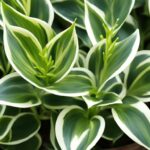Welcome to our Variegated Ginger Plant Care Guide! If you’re looking for tips on ginger plant care, variegated ginger care, or simply caring for ginger plants, you’ve come to the right place. In this guide, we’ll cover everything you need to know about growing variegated ginger and ensuring your plants thrive.
Variegated Ginger Plants are known for their beautiful large leaves with yellow and green striped variegation. They make a stunning addition to any garden or indoor space. Whether you choose to grow them in containers or plant them in the ground, these plants are sure to bring beauty and lush greenery to your surroundings.
When it comes to taking care of Variegated Ginger Plants, it’s important to provide them with the right conditions. These plants thrive in bright shade to full sun, so choose a location that offers the appropriate amount of light for optimal growth. If you’re growing them indoors, place them near large south-facing or western windows for ample sunlight.
Proper watering is crucial for the health of Variegated Ginger Plants. They like to stay moist, but be careful not to overwater them. Regular watering to keep the soil moist, along with well-drained soil, will help ensure their well-being. Remember to use filtered room temperature water to avoid harmful particles that may be present in tap water.
To keep your Variegated Ginger Plants thriving, regular fertilizing is necessary. An all-purpose foliage fertilizer will provide the necessary nutrients for growth. Follow the instructions on the fertilizer packaging for best results.
When it comes to maintenance, pruning is essential. Remove any wilted, discolored, or damaged leaves to promote new growth and improve ventilation. Some gardeners choose to remove flower buds to highlight the beauty of the plant’s leaves. Pruning can be done throughout the growing season, as needed. Ensure proper ventilation to help the wounds heal.
In summary, caring for Variegated Ginger Plants involves providing the right light, water, nutrients, and maintenance. With a little attention and care, your plants will thrive and bring beauty to your space. Now, let’s dive deeper into the specifics of Variegated Ginger Plant care.
Choosing the Right Location for Your Variegated Ginger Plant
When it comes to caring for your variegated ginger plant, one of the most important factors to consider is choosing the right location. These plants thrive in bright shade to full sun, both indoors and outdoors. Whether you’re growing them in containers or planting them in the ground, providing the ideal amount of light is crucial for their growth and overall health.
Indoors, it’s best to place your variegated ginger plant near large south-facing or western windows. These locations will offer ample light exposure throughout the day. Outdoors, variegated ginger plants can tolerate full sun, but they also do well in light shade. Consider areas in your garden that receive a balanced amount of sunlight, ensuring your plant has access to both shade and sun.
By carefully selecting the right location for your variegated ginger plant, you can provide it with the optimal conditions to flourish. Whether you choose to grow it indoors or outdoors, remember to strike the right balance between light and shade to maintain a happy and healthy plant.
Table: Ideal Light Conditions for Variegated Ginger Plants
| Light Level | Location |
|---|---|
| Bright Shade | Indoors near large south-facing or western windows |
| Full Sun | Outdoors with direct sunlight exposure |
| Light Shade | Outdoors with partial sunlight exposure |
Watering and Fertilizing Your Variegated Ginger Plant
Proper watering and fertilizing are essential for the care of variegated ginger plants. Follow these tips to keep your plants healthy and thriving:
Watering
Variegated ginger plants prefer to stay moist, but it’s important not to overwater them. Water the plants regularly to keep the soil moist, but allow any excess water to drain completely to prevent root rot. To ensure the best results, use filtered room temperature water, as tap water may contain harmful particles that can affect the health of your plants.
Fertilizing
Regular fertilizing is important for providing the necessary nutrients for the growth and development of variegated ginger plants. Use an all-purpose foliage fertilizer and follow the instructions on the packaging for the correct application. Fertilize the plants according to the recommended schedule to promote healthy foliage and vibrant colors.
In addition to regular watering and fertilizing, it’s important to monitor the overall health of your variegated ginger plants. Keep an eye out for signs of stress, such as yellowing or wilting leaves, and adjust your care routine accordingly. With proper watering and fertilizing, your variegated ginger plants will flourish and add beauty to your garden or indoor space.

Table: Watering and Fertilizing Tips for Variegated Ginger Plants
| Watering Tips | Fertilizing Tips |
|---|---|
| – Water regularly to keep the soil moist | – Use an all-purpose foliage fertilizer |
| – Allow excess water to drain completely | – Follow the instructions on the packaging |
| – Use filtered room temperature water | – Fertilize according to the recommended schedule |
| – Avoid overwatering to prevent root rot | – Monitor the overall health of the plants |
By following these watering and fertilizing tips, you can ensure the proper care and maintenance of your variegated ginger plants. Remember to observe your plants closely and make adjustments to your care routine as needed. With the right care, your variegated ginger plants will thrive and bring joy to your gardening experience.
Pruning and Maintenance of Variegated Ginger Plants
Regular pruning is a crucial aspect of caring for your variegated ginger plants. By removing wilted, discolored, or damaged leaves, you not only enhance the overall appearance of the plant but also promote new growth and improve ventilation. Some gardeners even choose to remove flower buds to emphasize the beauty of the plant’s leaves. When it comes to pruning, timing is key. You can prune your variegated ginger plants throughout the growing season, as needed.
After pruning your variegated ginger plants, it’s important to take precautions to prevent fungal infections. Avoid touching the wounds with water, as excess moisture can increase the risk of infections. Instead, provide ample ventilation to help the wounds heal. This will ensure that your plants stay healthy and vibrant.
Proper maintenance of variegated ginger plants goes beyond just pruning. Regularly inspect your plants for any signs of pests or diseases. If you notice any issues, take immediate action to address them. Additionally, keep an eye on the surrounding area for any competing weeds that may impact the growth of your ginger plants. Removing weeds promptly will ensure that your plants receive the necessary nutrients and resources to thrive.
Adequate watering is also crucial for the maintenance of variegated ginger plants. Remember to water them frequently to keep the soil moist, but avoid overwatering to prevent root rot. Filtered room temperature water is the best choice, as tap water may contain harmful particles. Furthermore, fertilize your variegated ginger plants regularly with an all-purpose foliage fertilizer. This will provide the necessary nutrients for healthy growth and vibrant foliage.
In summary, proper pruning and maintenance are essential for the health and beauty of your variegated ginger plants. Regularly remove damaged leaves, provide ventilation for healing wounds, and stay vigilant against pests and diseases. Additionally, water your plants adequately and fertilize them regularly to support their growth and vibrancy. By following these tips, you can ensure that your variegated ginger plants thrive and bring a touch of exotic beauty to your space.
Conclusion
Caring for your Variegated Ginger Plants is essential to ensure their health and beauty. By following a few simple steps, you can keep your plants thriving and lush.
Firstly, choose a location that provides the right amount of light. Variegated Ginger Plants prefer bright shade to full sun, so find a spot that suits their needs. Whether indoors or outdoors, ample light is key to their growth.
Secondly, water your plants regularly but avoid overwatering. Variegated Ginger Plants like to stay moist, so make sure to keep the soil moist, but not waterlogged. Use filtered room temperature water to prevent any harm from tap water particles.
Lastly, prune your plants when necessary to maintain their health and appearance. Remove any wilted or damaged leaves to promote new growth. Pruning can be done throughout the growing season, and remember to provide proper ventilation for the wounds to heal.
With these simple care tips, your Variegated Ginger Plants will thrive and bring beauty to your space. Enjoy the lush greenery and the joy they bring to any garden or indoor area.
FAQ
Can Variegated Ginger Plants be grown indoors?
Yes, Variegated Ginger Plants can be grown indoors. Place them near large south-facing or western windows to provide ample light.
How often should I water Variegated Ginger Plants?
Variegated Ginger Plants like to stay moist but should not be overwatered. Water them often to keep the soil moist, but allow the excess water to drain completely.
What type of water should I use to water Variegated Ginger Plants?
Filtered room temperature water is best for Variegated Ginger Plants, as tap water may contain harmful particles.
How do I fertilize Variegated Ginger Plants?
Fertilize Variegated Ginger Plants regularly with an all-purpose foliage fertilizer to provide the necessary nutrients for growth. Follow the instructions on the fertilizer packaging for the best results.
When should I prune Variegated Ginger Plants?
Pruning can be done throughout the growing season, as needed. Remove any wilted, discolored, or damaged leaves to promote new growth and improve ventilation.
How do I prevent fungal infections after pruning Variegated Ginger Plants?
After pruning, be careful not to touch the wounds with water to prevent fungal infections. It’s also important to provide adequate ventilation to help the wounds heal.





